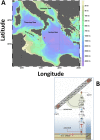Inertial bioluminescence rhythms at the Capo Passero (KM3NeT-Italia) site, Central Mediterranean Sea
- PMID: 28332561
- PMCID: PMC5362963
- DOI: 10.1038/srep44938
Inertial bioluminescence rhythms at the Capo Passero (KM3NeT-Italia) site, Central Mediterranean Sea
Abstract
In the deep sea, the sense of time is dependent on geophysical fluctuations, such as internal tides and atmospheric-related inertial currents, rather than day-night rhythms. Deep-sea neutrino telescopes instrumented with light detecting Photo-Multiplier Tubes (PMT) can be used to describe the synchronization of bioluminescent activity of abyssopelagic organisms with hydrodynamic cycles. PMT readings at 8 different depths (from 3069 to 3349 m) of the NEMO Phase 2 prototype, deployed offshore Capo Passero (Sicily) at the KM3NeT-Italia site, were used to characterize rhythmic bioluminescence patterns in June 2013, in response to water mass movements. We found a significant (p < 0.05) 20.5 h periodicity in the bioluminescence signal, corresponding to inertial fluctuations. Waveform and Fourier analyses of PMT data and tower orientation were carried out to identify phases (i.e. the timing of peaks) by subdividing time series on the length of detected inertial periodicity. A phase overlap between rhythms and cycles suggests a mechanical stimulation of bioluminescence, as organisms carried by currents collide with the telescope infrastructure, resulting in the emission of light. A bathymetric shift in PMT phases indicated that organisms travelled in discontinuous deep-sea undular vortices consisting of chains of inertially pulsating mesoscale cyclones/anticyclones, which to date remain poorly known.
Conflict of interest statement
The authors declare no competing financial interests.
Figures






References
-
- Robison B. H. Deep pelagic biology. J. Exp. Mar. Biol. Ecol. 300, 253–272 (2004).
-
- Widder E. A. Bioluminescence and the pelagic visual environment. Mar. Freshwat. Behav. Physiol. 35, 1–26 (2002).
-
- Aguzzi J. & Company J. B. Chronobiology of deep-water decapod crustaceans on continental margins. Adv. Mar. Biol. 58, 155–225 (2010). - PubMed
-
- Haddock S. H. D., Moline M. A. & Case J. F. Bioluminescence in the sea. Ann. Rev. Mar. Sci. 2, 443–493 (2010). - PubMed
-
- Aguzzi J. et al.. Activity rhythms in the deep-sea: a chronobiological approach. Front. Biosci. 16, 131–150 (2011). - PubMed
LinkOut - more resources
Full Text Sources
Other Literature Sources
Miscellaneous

